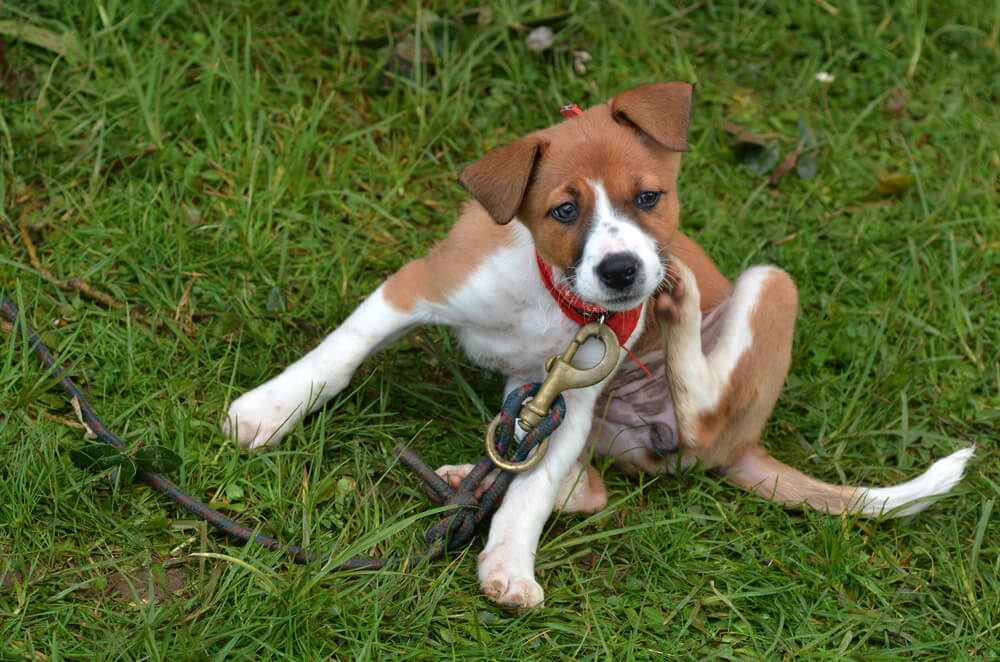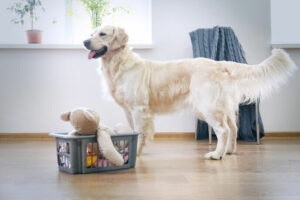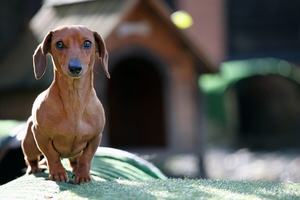Dog grooming is important to the health and well-being of your pet, it also happens to be a big business. Millions of dollars are spent every year by pet owners seeking to pamper their dogs and keep them looking their best.
If you don’t always have time to shampoo your pooch, or if you are simply looking to give your pet a treat, professional grooming is ideal. For regular baths and to help get rid of fleas, you can easily create your own mixture at home for a fraction of the price.
Most ingredients needed to create a DIY flea shampoo for dogs are easy to find. With the exception of essential oils, chances are you probably have them all lurking around your home.
What Essential Oils Kill Fleas on Dogs?
Several essential oils are effective in repelling biting insects such as fleas and ticks. Some oils can’t be used directly on the skin, and others should only be used on large breeds, however, they are all effective.
These oils are:
- Eucalyptus Oil
- Citronella Oil
- Lavender Oil
- Cedarwood Oil
- Lemongrass Oil
- Basil Oil
- Rosemary Oil
- Thyme Oil
- Rose Geranium Oil
Fleas, ticks, and other biting insects can cause irritation to a dog's skin, thankfully there are also soothing home remedies that can help alleviate their discomfort.
Oatmeal has long been an effective ingredient that can help calm inflamed skin, reduce itchiness and restore moisture to dry areas.
Coconut oil is also highly moisturizing while also helping to disinfect wounds on the skin caused by bug bites. An added bonus of using coconut oil is that your dog will be left with a soft, shiny coat of fur after their bath. To apply coconut oil topically, simply rub a tiny amount onto your hands and then gently pat your dog’s coat. Run your fingers through the fur, and massage the oil deep onto their skin, taking special care to coat problem areas.
To keep ticks and fleas from returning, you can add apple cider vinegar to your pet grooming routine as well.
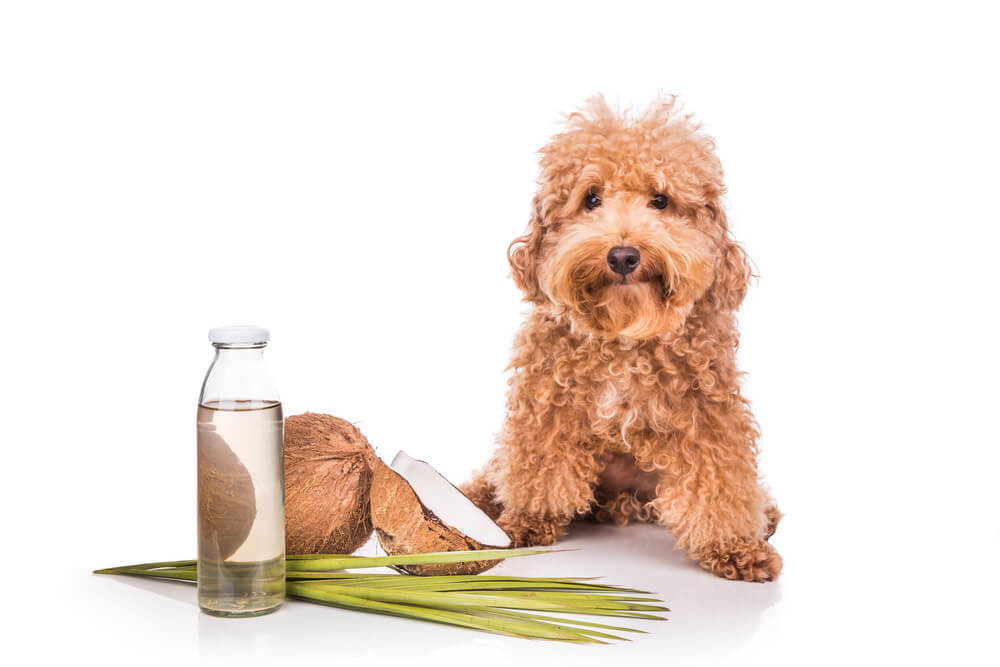
How to Use Essential Oils Safely on Dogs?
Essential oils are a safe and effective way to get rid of fleas, but it is important to use them properly to keep your dogs safe.
Always dilute essential oils in water before applying them to your pet.
You can dilute them for use in sprays, shampoo, or in their bathwater. Never apply essential oils directly to the skin of your pet. Not only can this cause irritation, but it can also become toxic at certain levels.
Always avoid putting essential oils near the eyes, nose, mouth, and privates of your pet. These areas are more sensitive and even diluted essential oils can cause irritation.

5 Ways to Prevent and Get Rid of Fleas on Dogs
According to the Center for Disease Control, there are more than 2,000 species of fleas. Fleas, worms and germs thrive in the modern home environment with central heating and humidity and they are the most common causes of illnesses in pets.
The most common health risks of fleas and dustmites for pets are perennial itching and an allergic reaction. An adult female flea can live for more than three weeks and lay 20-30 eggs each day.
You should check your dog for fleas at least twice a week. Early detection is key to getting rid of and preventing fleas quickly and easily.
Studies have shown that most effecting ways at preventing and killing fleas on dogs and cats are flea solutions such as collars and pills.
There are also all-natural remedies for fleas; which, while they're less harmful to use, they may not be as effective as commercial products. Flea sprays, bombs and powders are available to treat your carpeting and upholstery.
1. Frequent Combing
If you think your dog has fleas, there are a few things you can do to get rid of them. To start, if you have a long-haired pet, you should invest in a flea comb.
Spend some time grooming your pet once or twice a week to remove pests paying close attention to the neck and tail, just make sure to dunk them in a bowl of water to kill them.
2. Regular Dog Shampooing
Bathing is the easiest and most practical method to kill fleas and flea eggs on a dog. A dog shampoo should be part of a weekly flea elimination regimen and not a single do-all solution.
This will have the added bonus of giving your pet a shiny coat after every wash.
You can use a commercial shampoo that contains pyrethrin like Ovitrol Plus Dog Flea Shampoo, or you can create a DIY shampoo with essential oils.
When giving your dog a flea bath, let the shampoo sit in his coat for at least 10 minutes to allow sufficient time to kill all of the fleas before rinsing it out.
Take Note: Studies from U.S. Centers of Disease Control (CDC) show there is a correlation between illnesses associated with the use of some flea control products. One of the frequently mentioned ingredients is the use of pyrethrins; however, pyrethrin or pyrethroid products are found to be completely safe for dogs but toxic to cats.
Once your pet is clean, you will need to ensure that their bedding. The best defense against fleas in the house is a vacuum cleaner.
3. Pet Bed Hygiene
Maintaining hygiene standards in pet bedding is one of the best ways of protecting them from fleas, worms, dustmites, moulds, bacteria, viruses and fungi that can cause infections and dermatitis.
Wash dog beds in hot water in the medium cycle every couple of days.
When placing it in the dryer, use the highest heat setting.
4. Remove Fleas From Your Home
The best defense against fleas in the house is a vacuum cleaner since vacuuming will get rid of a flea in any stage of its life cycle.
As soon as you've finished vacuuming, get rid of the contents (bag or a canister) in an outdoor trash can immediately.
5. Spot Treatments
For spot treatments, you can make a natural solution of essential oils mixed with water. You can spray your dog, furniture, dog bed, collars, and play areas to rid them of fleas.
If none of the above methods work, you can schedule an appointment with your vet to get oral or topical flea treatment.
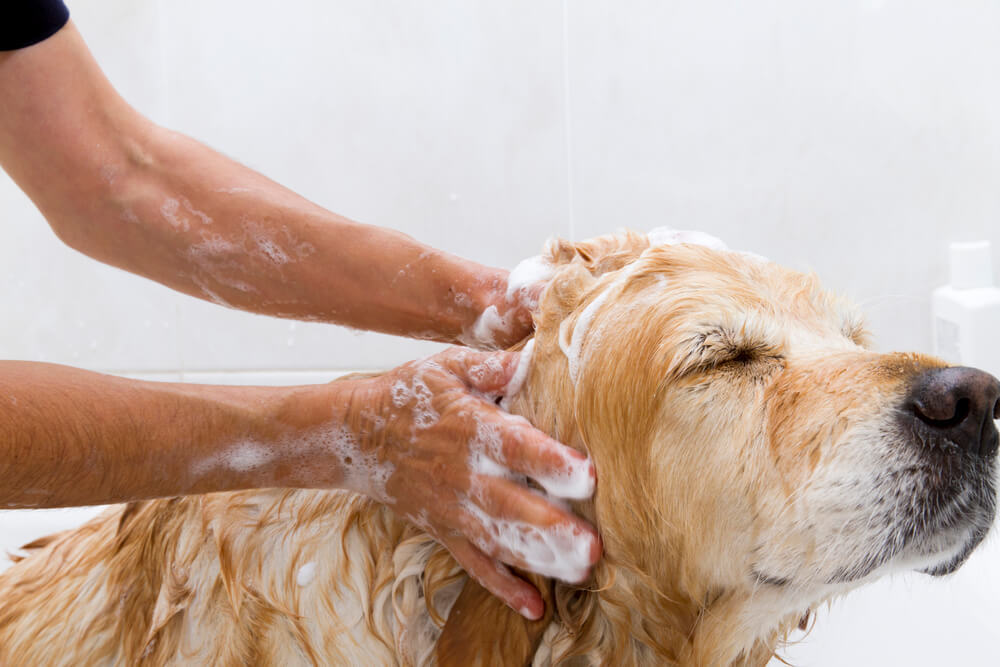
How To Make Your Own All-Natural DIY Dog Flea Shampoo
1. DIY Dog Shampoo For Fleas Recipe
You'll Need
- 1 cup water
- 1 tbsp Dr. Bronner’s liquid castile soap
- 3 drops of Citronella essential Oil
- 3 drops of Eucalyptus essential Oil
- 3 drops of Purification
- 3 drops of Cedarwood essential oil
Note 1: Castile soap contains natural and biodegradable cleansers, is safe to use on dogs and is filled with rich moisturizers like jojoba oil, olive oil and coconut oil.
Note 2: Purification oil is an excellent ingredient to use for repelling fleas and contains citronella, tea tree, lemongrass and rosemary.
Directions
Step #1 – Take one cup of water and place it in a bowl or bottle.
Step #2 – Add 3 drops each of citronella, cedarwood, and eucalyptus oil to the water.
Step #3 – Add 3 drops of purification and one tbsps of Dr. Bronner’s castile soap to the mixture.
Step #4 – Shake well to incorporate the ingredients.
Step #5 – Shampoo your dog well avoiding the mouth and eyes. For small dogs, use 3-5 table spoons. Let it sit for 3-5 minutes and rinse thoroughly. If there are dead fleas, rinse them down the drain. You may need to use a comb to remove any dead fleas that are stuck in the dog's hair.
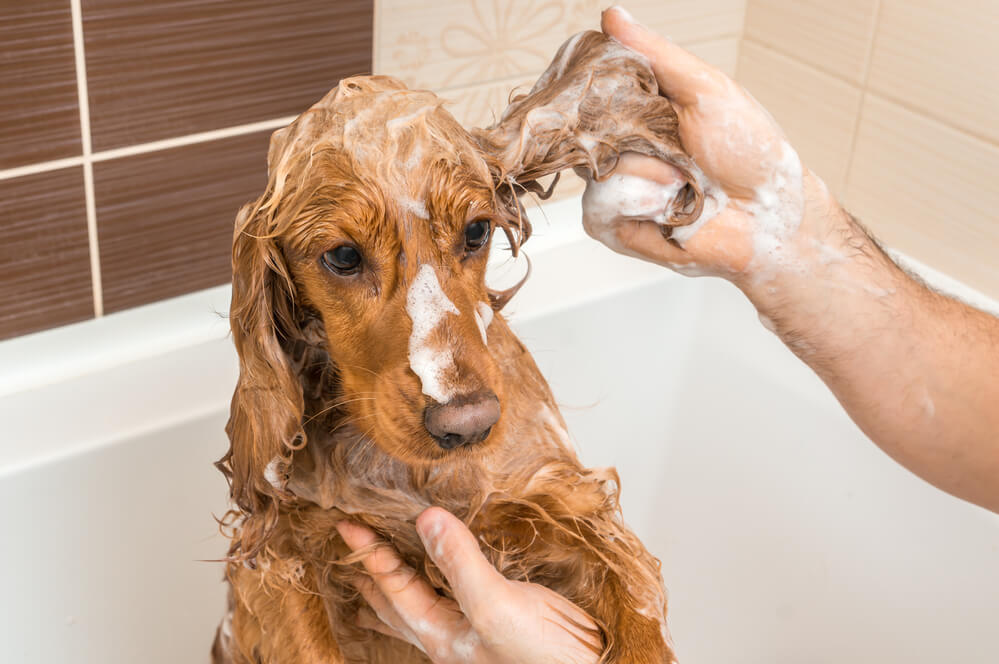
2. Homemade Dog Flea Shampoo for Pets With Sensitive Skin
You'll Need:
- 1 cup of distilled water
- 1/2 cup oatmeal (pulsed into flour)
- 2 tbsps fractionated coconut oil
- 1/2 cup Dr. Bronner’s castile soap
- 3-4 drops Lavender Essential Oil
- ¼ cup of Apple Cider Vinegar
Directions
Step #1 – Use bottled water or boil water. Take 1 cup and add it to a bowl or bottle.
Step #2 – Take half of a cup of oatmeal and grind it into flour.
Step #3 – Add your wet ingredients to the water and mix well.
Step #4 – Next, mix in the fractionated coconut oil and oatmeal flour.
Step #5 – Shake well to incorporate the ingredients.
Step #6 – Shampoo your dog well avoiding the mouth and eyes and massage the shampoo gently into his fur and skin. Leave it on for up to 5 minutes and rinse well. Use a comb to remove any dead fleas.
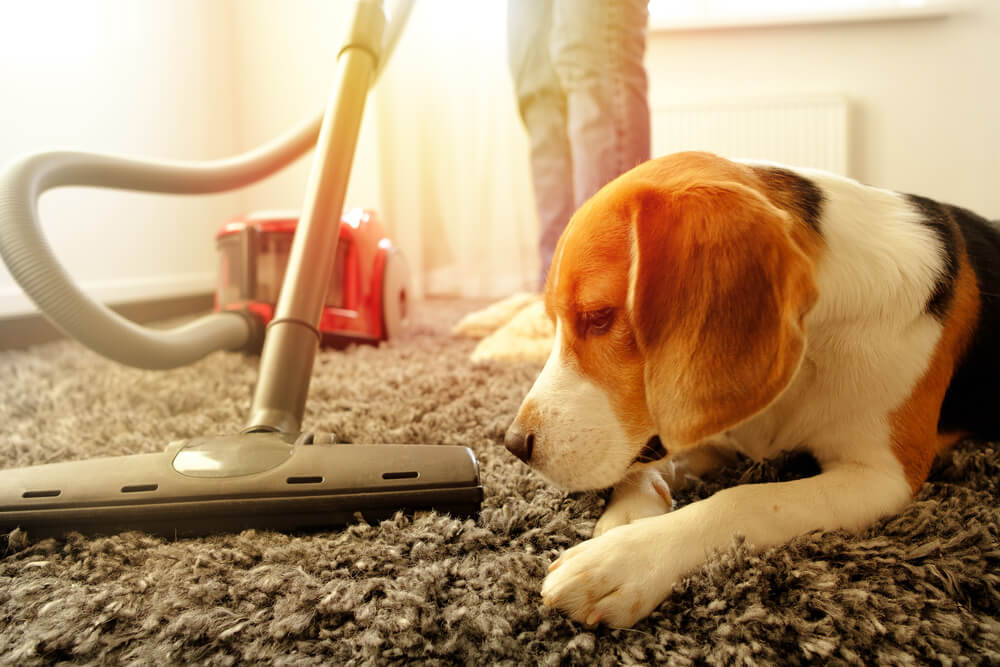
How To Get Rid of Fleas in the House
Fleas are one of the most annoying pests and can often be quite difficult to get rid of. They mainly attach themselves to animals, however, they can also infest your home and furniture.
Signs of That are Fleas in Your House
The most common sign of a flea infestation in your home is itching. If you notice your pets, or even yourself dealing with unseen irritation, it might be fleas. These little bugs are also big enough to be seen with the naked eye. Flea bites often look like clusters of small, itchy bites in concentrated areas.
They can jump as high as 13 inches, so if you sit still, you may catch them hopping to and fro.
Clean Your Home Thoroughly
To get rid of and prevent fleas, clean your home thoroughly.
If you believe you have fleas in your bed, you should wash all your bedding in hot water, including your bedsheets, blankets, pillows, and mattress pad.
Next, start by vacuuming all areas that you want to treat, including carpets, bare floors, upholstery, furniture, cracks, and crevices where fleas can hide.
Get rid of the vacuum bags or their contents outside after every session.
Next, use a good flea treatment on your home which can be safely used on your furniture, upholstery, and carpet to kill fleas at the different stages of their life cycle: eggs, larvae, and adult fleas roaming around your house.
Stay up to date with your treatments to prevent a resurgence of the flea population.

Source: Chewy/ Jon Lofdahl
How To Get Fleas Out of a Dog Bed
Your furry friend is a member of the family and if they are not getting the sleep they need due to fleas, then no one will be happy.
Signs Your Dog Has Fleas
If you notice that your pet is restless every time they lay on their dog bed; chances are it is infested with fleas. You can also spot fleas in the bed if left unattended for a few minutes. Do you notice your dog whining or biting itself while it lays on the bed?
These are also signs of a flea infestation in your pet's bed.
Here are some symptoms of flea bites on dogs to look for include:
- Itching, more so than usual
- Irritated red skin or scabs
- Skin biting
- Hair loss
Check your dog's armpit and groin areas for signs of fleas.
To check your pet's bedding for evidence of fleas, with the naked eye, infested pet bedding will look like it has been sprinkled with salt and pepper.
While very small flea larvae are still visible. The flea larvae and eggs are white and the specks of adult flea feces mixed in with them are black.
Clean Your Pet Bed
Before moving the bed, vacuum it thoroughly to remove as many eggs and larvae as possible.
If your dog's bed is washable use - a 1/3 cup of Dr. Bronner’s in a top loading washer and add 1/2 cup vinegar to the rinse cycle (halve these measurements for an HE washer).
By washing and drying bedding at hot temperatures with soap will kill all flea stages.
Use a flea killer to rid your pet’s bedding of flea larvae and eggs.
To prevent the bed from becoming infested again, make sure to treat your pet and your home for fleas as well.

